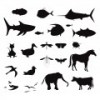
Image Credit: The Scientist; R. Hartley, Univ of Manchester; T. Larson, Black Hills Inst.; G. Stewart; SLAC National Accelerator Laboratory
I just read the neatest article in Science Magazine on how a team led by researchers from the University of Manchester has re-created the pigmentation of fossilized birds like the artist's rendition of the extinct C. sanctus above. They accomplished this by mapping possible chemical residues of melanin pigments using synchrotron x-rays. The researchers believe that trace metals found in the fossils, such as copper, calcium and iron, may be chemical residues of melanin. By mapping these residues, they were able to re-create the coloring of extant and extinct birds.
Source:
RA Wogelius, PL Manning, HE Barden, NP Edwards, SM Webb, WI Sellers, KG Taylor, PL Larson, P Dodson, H You, L Da-qing, U Bergmann. Trace Metals as Biomarkers for Eumelanin Pigment in the Fossil Record. Science 333 (6049): 1622-1626, 2011.
